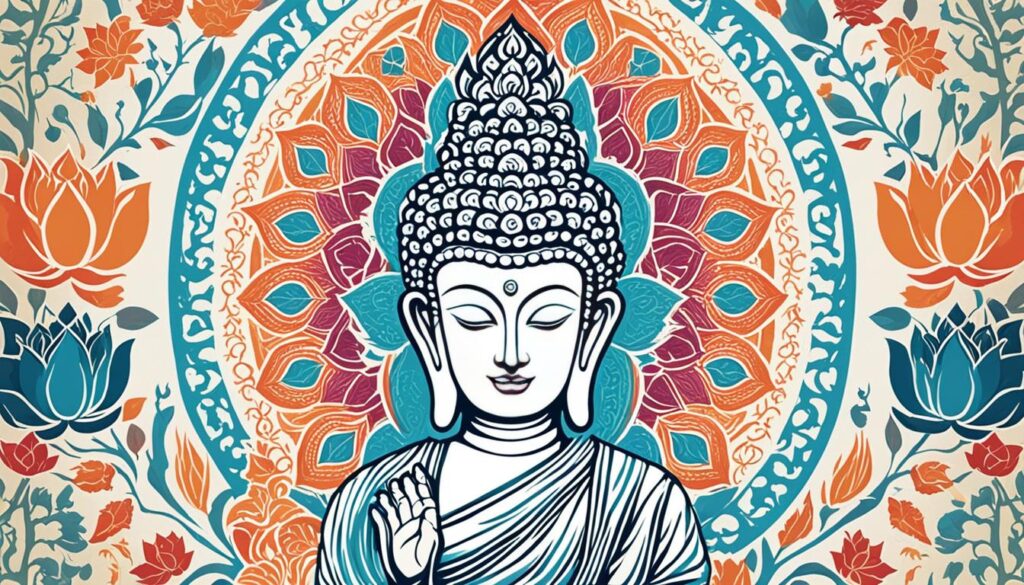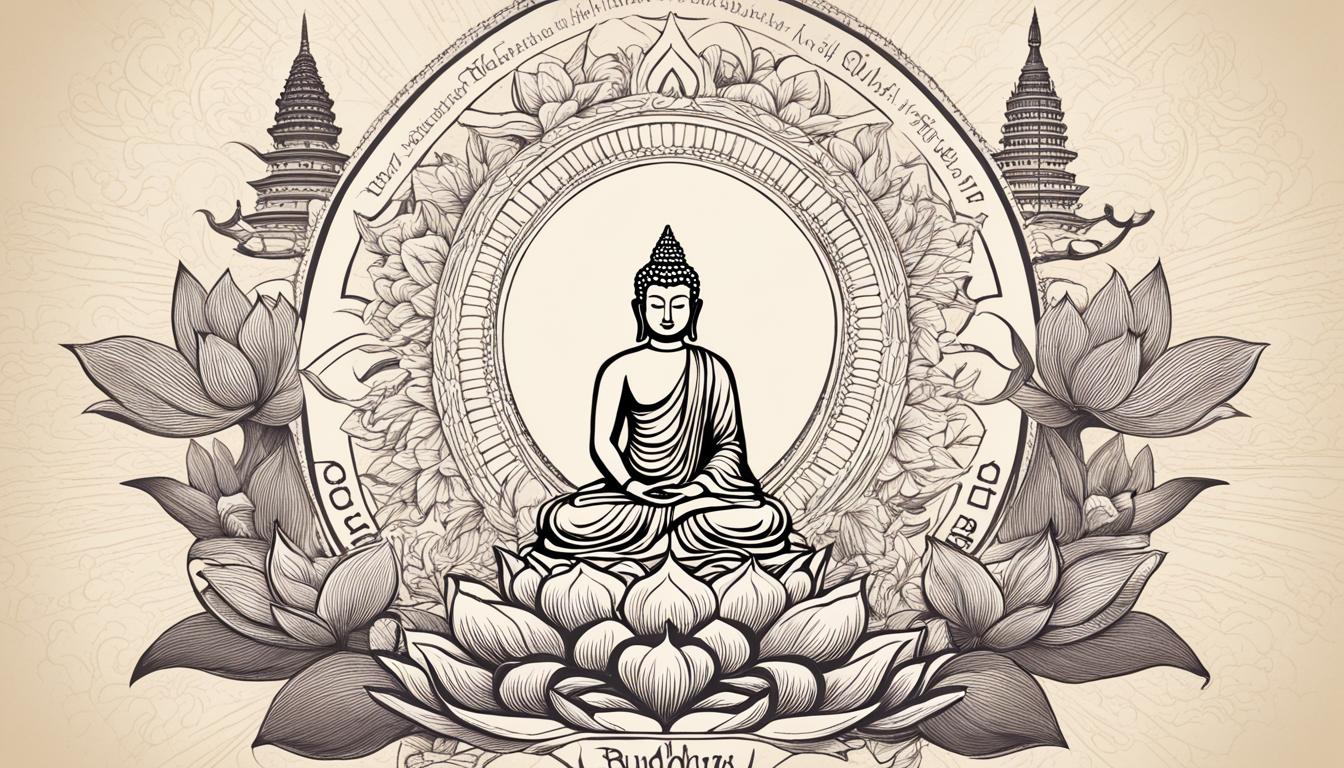“Thousands of candles can be lit from a single candle, and the life of the candle will not be shortened. Happiness never decreases by being shared.” – Buddha
Buddhism, with its profound teachings and principles, has captured the hearts and minds of millions of people worldwide. As one of the major world religions, its impact extends far beyond its historical roots in East and Southeast Asia. Buddhism has touched the lives of individuals from every corner of the globe, offering guidance, enlightenment, and a path towards inner peace.
With an estimated 500 million to one billion followers globally, Buddhism boasts a sizable and diverse community. It consists of people from different cultures, backgrounds, and walks of life who have found solace and wisdom in the teachings of the Buddha. From the vibrant monasteries in Thailand to the serene temples in Japan, Buddhism has created a rich tapestry of beliefs, practices, and traditions.
Key Takeaways:
- Buddhism has a significant global following, with an estimated 500 million to one billion followers worldwide.
- The teachings of Buddhism have transcended cultural boundaries and continue to inspire individuals from various backgrounds.
- The diverse Buddhist community encompasses people from all walks of life, united by their pursuit of enlightenment and inner peace.
- Buddhism’s impact extends beyond religious boundaries, influencing philosophy, ethics, and personal well-being.
- The teachings of the Buddha provide a path towards happiness and wisdom, encouraging compassion, mindfulness, and self-transformation.
Buddhism Beliefs and Practices
Buddhism is a non-theistic faith with a profound focus on achieving enlightenment and inner peace. Unlike traditional religions that worship a deity, followers of Buddhism strive for personal enlightenment and understanding of the world. This journey towards enlightenment, also known as nirvana, involves embracing specific beliefs and engaging in various practices.
Buddhist Enlightenment: The Path to Nirvana
The essence of Buddhist philosophy lies in the pursuit of enlightenment, which is attainable through dedicated practice. Central to this path are the three pillars of Buddhism: morality, meditation, and wisdom. Moral conduct forms the foundation for a wholesome and virtuous life, whereas meditation cultivates mindfulness and concentration. Wisdom is developed through contemplation, understanding the true nature of reality, and gaining insights into the workings of the mind and ego.
The Four Noble Truths and the Eightfold Path
Buddhist beliefs revolve around the Four Noble Truths, a fundamental framework that offers profound insights into the nature of suffering and the path to liberation. These truths are:
- The truth of suffering
- The truth of the origin of suffering
- The truth of the cessation of suffering
- The truth of the path to the cessation of suffering
Complementing the Four Noble Truths is the Eightfold Path, a guide to ethical living and the development of wisdom. It consists of eight interconnected principles, including right understanding, right intention, right speech, right action, right livelihood, right effort, right mindfulness, and right concentration.
Karma, Reincarnation, and Buddhist Ethics
Buddhism teaches the concept of karma, which states that every action has consequences. By cultivating positive thoughts, speech, and actions, individuals can accumulate positive karma, leading to a more favorable future. Conversely, negative actions generate negative karma. The belief in rebirth or reincarnation suggests that this cycle of life and death continues until one attains enlightenment.
Buddhist ethics emphasize the importance of compassion, mindfulness, and ethical conduct. By observing specific moral precepts, such as refraining from harming living beings, practicing honesty, and cultivating generosity, individuals cultivate a compassionate and ethically aware mindset.
Buddhist Symbols: Representations of Beliefs
Buddhist symbols play a significant role in representing and manifesting key beliefs and teachings. These symbols act as visual reminders of the path to enlightenment and inspire practitioners in their spiritual journey. Some of the prominent symbols in Buddhism include:
- The Lotus Flower: Symbolizes purity, spiritual awakening, and the journey from darkness to light.
- The Dharma Wheel: Represents the Eightfold path and serves as a metaphor for Buddhist teachings and the cycle of life.
- The Swastika: In Buddhism, the swastika symbolizes harmony, auspiciousness, and the eternal cycle of life.

| Buddhist Beliefs | Buddhist Practices |
|---|---|
| Karma and Reincarnation | Moral Conduct |
| The Four Noble Truths | Meditation |
| Buddhist Ethics | Contemplation and Wisdom |
Founder of Buddhism
In the 5th century B.C.E, Siddhartha Gautama, known as “the Buddha,” established Buddhism as a profound spiritual path. Born into a privileged family in present-day Nepal, Siddhartha’s life of luxury exposed him to the suffering inherent in the world. Moved by this deep sense of compassion, he embarked on a spiritual journey, seeking answers to life’s fundamental questions.
Renouncing his wealth and privileges, Siddhartha devoted himself to the pursuit of enlightenment. Under a Bodhi tree, he attained profound realizations and achieved a state of awakening that transformed him into the enlightened Buddha.
For the remainder of his life, the Buddha traveled extensively, sharing his wisdom and insights with others. He taught people how to find inner peace and wisdom, guiding them on the path to enlightenment. His teachings, often expressed in parables and sermons, emphasized compassion, mindfulness, and ethical living.
Through his teachings, the Buddha fundamentally transformed the lives of countless individuals, offering them a path to liberation from suffering. The essence of Buddhism, as established by its founder Siddhartha Gautama, continues to inspire and guide millions of people worldwide.

Life and Enlightenment of Siddhartha Gautama
Siddhartha Gautama was born into a privileged family in present-day Nepal. Growing up surrounded by opulence, he was shielded from the harsh realities of the world. However, the experience of witnessing suffering deeply impacted Siddhartha, stirring a desire to understand the nature of human existence.
In search of truth and meaning, Siddhartha embarked on a spiritual quest, renouncing his comfortable life and embracing a life of austerity. For years, he traversed the forests and engaged in deep meditation, striving to unlock the mysteries of existence.
After years of rigorous spiritual practice, Siddhartha experienced a profound awakening under the Bodhi tree. This transformative event marked the pinnacle of his spiritual journey and marked the birth of a new era – Buddhism.
Types of Buddhism
Buddhism has evolved into various forms and schools of thought throughout its history. The three main types of Buddhism practiced worldwide include:
Theravada Buddhism
Theravada Buddhism, also known as the School of the Elders, is the oldest surviving branch of Buddhism. It is widely practiced in Sri Lanka, Thailand, Cambodia, Myanmar, and Laos. Theravada Buddhism emphasizes the importance of individual effort in attaining enlightenment and follows the teachings of the Pali Canon, the oldest Buddhist scriptures.
Mahayana Buddhism
Mahayana Buddhism, also known as the Great Vehicle, is the largest branch of Buddhism, primarily practiced in China, Japan, Korea, and Vietnam. Mahayana Buddhism focuses on the enlightenment of all beings and places a strong emphasis on compassion and the Bodhisattva path. Mahayana scriptures include the Lotus Sutra, the Heart Sutra, and the Diamond Sutra.
Tibetan Buddhism
Tibetan Buddhism, also known as Vajrayana Buddhism, is practiced primarily in Tibet, Bhutan, and Mongolia. It incorporates elements of Buddhism, Bon, and Tibetan culture. Tibetan Buddhism is known for its elaborate rituals, practices, and a deep emphasis on meditation. The Dalai Lama is the spiritual leader of Tibetan Buddhism.
Zen Buddhism
Zen Buddhism, also known as Chan Buddhism, originated in China and later spread to Japan, Korea, and Vietnam. Zen emphasizes direct experience and meditation to achieve enlightenment. It is known for its minimalist aesthetic, simplicity, and the use of enigmatic and thought-provoking Zen koans. Zen Buddhism has had a significant impact on art, culture, and philosophy.
Image:

table {
border-collapse: collapse;
width: 100%;
}
th, td {
border: 1px solid #ddd;
padding: 8px;
text-align: left;
}
th {
background-color: #f2f2f2;
}
Buddhist Traditions
| Buddhist Tradition | Key Characteristics | Main Geographic Areas |
|---|---|---|
| Theravada Buddhism | Emphasis on individual practice, meditation, and adherence to monastic rules | Sri Lanka, Thailand, Cambodia, Myanmar, Laos |
| Mahayana Buddhism | Focus on compassion, Bodhisattva path, and the enlightenment of all beings | China, Japan, Korea, Vietnam |
| Tibetan Buddhism | Elaborate rituals, practices, and reverence for Tibetan cultural elements | Tibet, Bhutan, Mongolia |
| Zen Buddhism | Emphasis on direct experience, meditation, and enigmatic Zen koans | China, Japan, Korea, Vietnam |
Key Beliefs and Practices in Buddhism
In Buddhism, there are key beliefs and practices that serve as a guiding light on the path to enlightenment. These teachings offer profound insights into the nature of existence and provide a framework for leading a virtuous and meaningful life.
The Four Noble Truths
- The truth of suffering (Dukkha): Acknowledging the existence of suffering and its various forms.
- The truth of the origin of suffering (Samudaya): Understanding the causes and conditions that give rise to suffering.
- The truth of the cessation of suffering (Nirodha): Realizing that the end of suffering is attainable through the cessation of its causes.
- The truth of the path to the cessation of suffering (Magga): Following the Eightfold Path to achieve liberation from suffering.
The Eightfold Path
The Eightfold Path serves as a guide to overcoming suffering and attaining enlightenment. It consists of the following interconnected aspects:
- Right View: Understanding the nature of reality and the Four Noble Truths.
- Right Intention: Cultivating wholesome intentions and letting go of harmful desires.
- Right Speech: Practicing honest, kind, and non-harming speech.
- Right Action: Acting in ways that promote harmony, integrity, and compassion.
- Right Livelihood: Engaging in a livelihood that aligns with Buddhist principles.
- Right Effort: Cultivating wholesome qualities and abandoning unwholesome ones.
- Right Mindfulness: Developing moment-to-moment awareness and present-centeredness.
- Right Concentration: Cultivating focused and meditative states of mind.
Buddhist Moral Precepts
The Buddhist moral precepts provide guidance on ethical conduct and promote harmony within oneself and society. They include:
- Refraining from killing or causing harm to living beings.
- Refraining from stealing or taking what is not freely given.
- Refraining from engaging in sexual misconduct or harmful sexual behavior.
- Refraining from false speech or dishonesty.
- Refraining from consuming intoxicants that lead to heedlessness.
Buddhist Scriptures
The Buddhist scriptures, known as the Tripitaka or “Three Baskets,” contain the teachings of the Buddha. They provide guidance, inspiration, and a deep reservoir of wisdom for practitioners. The Tripitaka is divided into three sections:
- Vinaya Pitaka: Rules and guidelines for monastic discipline.
- Sutta Pitaka: Discourses and teachings of the Buddha.
- Abhidhamma Pitaka: Higher philosophical and psychological analysis of the Buddha’s teachings.
These scriptures are a valuable resource for deepening one’s understanding of Buddhist concepts and practices.
Dalai Lama
The Dalai Lama is a spiritual leader and the most prominent figure in Tibetan Buddhism. The Dalai Lama is believed to be the reincarnation of previous Dalai Lamas, and he serves as a compassionate and wise guide for his followers. His teachings emphasize compassion, mindfulness, and the pursuit of happiness and peace. The Dalai Lama’s influence extends beyond Buddhism, with his teachings and advocacy for human rights capturing the hearts and minds of people worldwide.

| Buddhist Moral Precepts | Four Noble Truths | Eightfold Path | Buddhist Scriptures | Dalai Lama |
|---|---|---|---|---|
| Refraining from killing or causing harm to living beings. | The truth of suffering (Dukkha) | Right View | Vinaya Pitaka | Spiritual leader and advocate |
| Refraining from stealing or taking what is not freely given. | The truth of the origin of suffering (Samudaya) | Right Intention | Sutta Pitaka | Compassionate and wise guide |
| Refraining from engaging in sexual misconduct or harmful sexual behavior. | The truth of the cessation of suffering (Nirodha) | Right Speech | Abhidhamma Pitaka | Ambassador of peace and happiness |
| Refraining from false speech or dishonesty. | The truth of the path to the cessation of suffering (Magga) | Right Action | ||
| Refraining from consuming intoxicants that lead to heedlessness. | Right Livelihood |
Conclusion
Buddhism’s global impact is undeniable, with millions of followers embracing its teachings across diverse traditions and geographical regions. The path to enlightenment, as outlined by Buddhism, provides invaluable insights into personal and societal harmony, mindfulness, compassion, and the ability to address modern challenges. By embracing Buddhism and its principles, you embark on a transformative journey towards self-discovery, profound wisdom, and a deeper understanding of the world.
The influence of Buddhism transcends religious boundaries, shaping philosophy, ethics, and the pursuit of inner peace and wisdom. Its teachings offer guidance and inspiration in navigating the complexities of our modern world. By integrating the wisdom of Buddhism, we can find balance, meaning, and tranquility amidst the chaotic nature of contemporary life.
Embracing Buddhism empowers individuals to cultivate personal growth, nurture empathy, and foster harmonious relationships. Its principles advocate for compassion and mindfulness in all aspects of life, leading to a more interconnected and compassionate society. By embodying the teachings of Buddhism, we can contribute to the collective well-being and harmony of our communities, fostering a more peaceful and compassionate world.
FAQ
How many followers does Buddhism have worldwide?
Buddhism is estimated to have between 500 million to one billion followers globally.
What are some key beliefs and practices in Buddhism?
Key beliefs and practices in Buddhism include morality, meditation, wisdom, karma, reincarnation, and the Four Noble Truths.
Who founded Buddhism?
Buddhism was founded by Siddhartha Gautama, also known as “the Buddha,” in the 5th century B.C.E.
What are the different types of Buddhism?
The main types of Buddhism practiced worldwide are Theravada Buddhism, Mahayana Buddhism, Tibetan Buddhism, Zen Buddhism, and Nichiren Buddhism.
What are some important aspects of Buddhism?
Important aspects of Buddhism include the Buddha’s moral precepts, the Four Noble Truths, the Eightfold Path, Buddhist scriptures, and the guidance of figures like the Dalai Lama.
What is the global impact of Buddhism?
Buddhism’s teachings offer insights into personal and societal harmony, mindfulness, compassion, and addressing modern challenges. Embracing Buddhism can lead individuals on a journey towards enlightenment, self-discovery, and a deeper understanding of the world.

